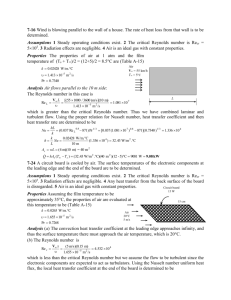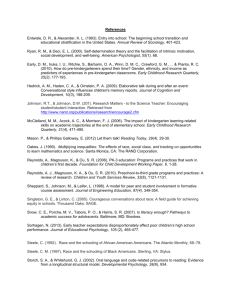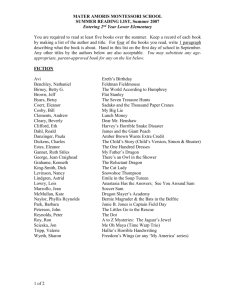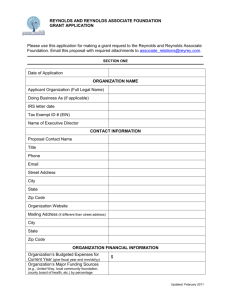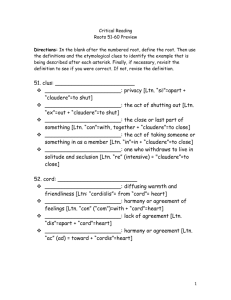a formulation for the resistive wall boundary condition in nimrod
advertisement
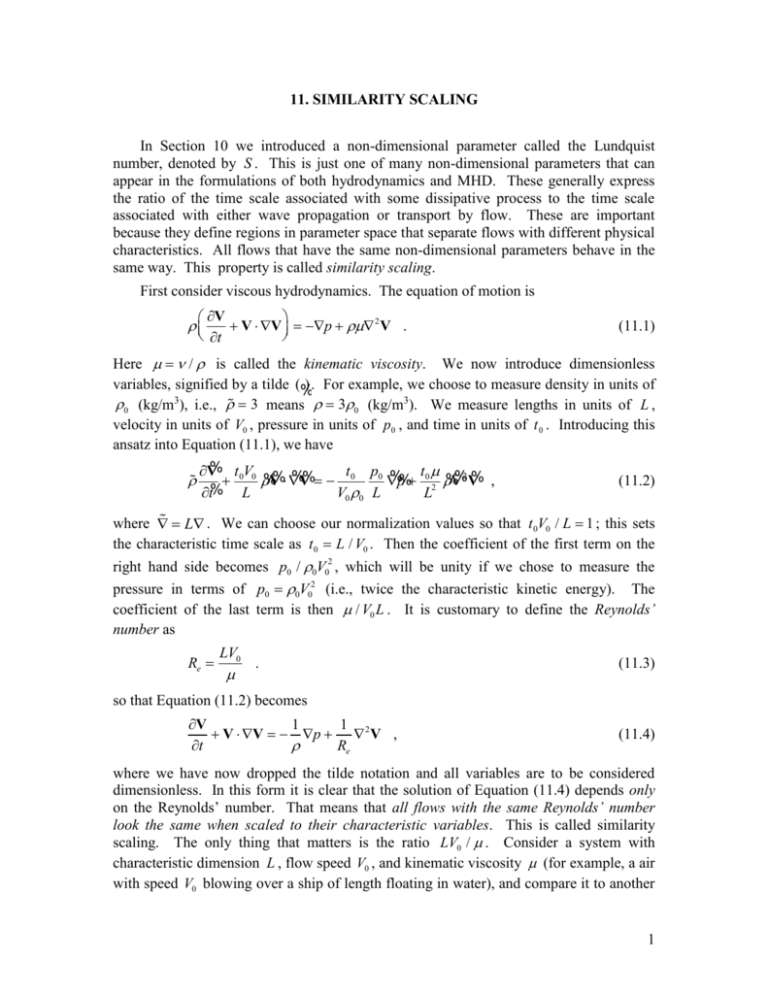
11. SIMILARITY SCALING In Section 10 we introduced a non-dimensional parameter called the Lundquist number, denoted by S . This is just one of many non-dimensional parameters that can appear in the formulations of both hydrodynamics and MHD. These generally express the ratio of the time scale associated with some dissipative process to the time scale associated with either wave propagation or transport by flow. These are important because they define regions in parameter space that separate flows with different physical characteristics. All flows that have the same non-dimensional parameters behave in the same way. This property is called similarity scaling. First consider viscous hydrodynamics. The equation of motion is V V V p 2 V . t (11.1) Here / is called the kinematic viscosity. We now introduce dimensionless variables, signified by a tilde (% ) . For example, we choose to measure density in units of 3 0 (kg/m ), i.e., 3 means 30 (kg/m3). We measure lengths in units of L , velocity in units of V0 , pressure in units of p0 , and time in units of t 0 . Introducing this ansatz into Equation (11.1), we have % t 0V0 V %V %p t 0 % %2 V % % t 0 p0 % % , (11.2) %V 2 % t L V0 0 L L where L . We can choose our normalization values so that t 0V0 / L 1 ; this sets the characteristic time scale as t 0 L / V0 . Then the coefficient of the first term on the right hand side becomes p0 / 0V02 , which will be unity if we chose to measure the pressure in terms of p0 0V02 (i.e., twice the characteristic kinetic energy). The coefficient of the last term is then / V0 L . It is customary to define the Reynolds’ number as Re LV0 . (11.3) so that Equation (11.2) becomes V 1 1 V V p 2 V , t Re (11.4) where we have now dropped the tilde notation and all variables are to be considered dimensionless. In this form it is clear that the solution of Equation (11.4) depends only on the Reynolds’ number. That means that all flows with the same Reynolds’ number look the same when scaled to their characteristic variables. This is called similarity scaling. The only thing that matters is the ratio LV0 / . Consider a system with characteristic dimension L , flow speed V0 , and kinematic viscosity (for example, a air with speed V0 blowing over a ship of length floating in water), and compare it to another 1 system with the same V0 (wind speed) and viscosity (air and water), but with length l L . The systems will not look the same, even qualitatively. This is because the Reynolds’ number in the first case is Re LV0 / , but the Reynolds’ number in the second case is Re lV0 / (l / L)Re Re ; the Reynolds’ number is too small. In order to make them appear the same using the same materials (i.e., air and water), the wind velocity must increase by a factor of L / l . This is why many movie scenes of ships in storms don’t look realistic; they were filmed with a model ship in a bathtub, and the Reynolds’ number is too small! On the positive side, similarity scaling is the basis for wind tunnel experiments, which have been tremendously important in the development of advanced aircraft. The kinematic viscosity in Equation (11.1) has the dimensions of a diffusion coefficient, m2/sec. Indeed, if we drop the advection and pressure force, the velocity is seen to satisfy a diffusion equation V 2 V . t The characteristic time for viscous diffusion is L2 / , and the ratio of the viscous diffusion time scale to the flow time scale t 0 L / V0 is / t 0 LV0 / Re . The Reynolds’ number is fundamentally a ratio of the characteristic time scales of the system. Now consider the combination of Faraday’s law and Ohm’s law (sometimes called the induction equation) B V B 2 B . t 0 (11.5) Introducing non-dimensional variables and applying the same procedure as above, we find B 1 2 V B B , t RM (11.6) where RM LV0 ( / 0 ) (11.7) is the magnetic Reynolds’ number. The resistive diffusion time associated with Equation (11.5) is R L2 / ( / 0 ) , and so R / t 0 LV0 / ( / 0 ) RM . Again, the magnetic Reynolds’ number is the ratio of the resistive diffusion time to the flow time. If we choose instead V0 VA , the (as yet unmotivated) Alfvén time, then the magnetic Reynolds’ number becomes S R / A , the Lundquist number that was introduced in Section 10. Now consider MHD, and, for simplicity of discussion, we let 0 constant . We now must retain the Lorentz force J B in the equation of motion. Measuring the 2 current density in units of J 0 B0 / 0 L (from 0 J B ), and transforming to nondimensional variables, as before, we find that the coefficient of the non-dimensional Lorentz force is J 0 B0t 0 B2 t0 V2 0 A2 , 0V0 0 0 LV0 V0 (11.8) This strongly suggests measuring the velocity in terms of the Alfvén speed, whose square is VA2 B02 / 0 0 . Then the pressure is measured in terms of twice the magnetic energy density, p0 0VA2 B02 / 0 (which shows that the Alfvén speed is the speed at which the kinetic energy equals the magnetic energy). The Reynolds’ number becomes Se / A LVA / , which we will call the viscous Lundquist number (for lack of a better name). With these choices, the (constant density) non-dimensional MHD equations (neglecting energy) become 1 V V V p J B 2 V , t Se (11.9) and B 1 V B 2 B . t S (11.10) Solutions of the coupled MHD system appear the same (i.e., are similar) if both Se and S are the same. Situations in which either Se or S (or both) are different will behave differently. There are several other non-dimensional parameters that appear in the literature that are combinations of Se and S . For example, Pr S / Se / ( / 0 ) is called the magnetic Prandtl number. It measures the relative effects of viscous and resistive diffusion. Similarly, H SSe is called the Hartmann number. It is important in differentiating regimes in certain MHD flows, and also different operating regimes of some present magnetic fusion experiments. We have implied that the Reynolds’ number (and other non-dimensional parameters) can differentiate regimes in which systems that satisfy the same equations behave quite differently. This can be understood qualitatively as follows. Consider the case of sheared flow. Its effect is to distort the fluid, as shown in the figure below. The effect of diffusion is to smooth, or relax, the shear, and hence the distortion, as shown below. 3 Both of these processes are at work simultaneously. The Reynolds’ number is the ratio of the time scale associated with the smoothing and distortion processes, Re / t0 . When Re 1 the fluid is distorted faster than it can relax, and when Re 1 the fluid is relaxed faster than it can be distorted. Smoothing and distortion occur on the same time scale when Re ~ 1 , or on a length scale L0 ~ / V0 . Thus, flow with very large Reynolds’ number will tend to look distorted and disorganized, and the velocity field will look “spiky” (also called “turbulent”), while flow with very low Reynolds’ number will be exceedingly smooth, like molasses. Flows with intermediate Reynolds’ number will appear to be smooth, organized, and “laminar”. These flow regimes are illustrated below. From left to right, these figures can be thought of either as representing the same scale length with increasing viscosity, or representing the same viscosity with decreasing scale length. In either case, the characteristic length scale on which the structure is resolved is L0 . Similar remarks apply to the structure of the magnetic field as a function of either the magnetic Reynolds’ number RM , or the Lundquist number S . However, in this case the structure in the current density is even sharper than that of the magnetic field, since J ~ B / x . The spikes in the structure of the current density are called current sheets. These will become of central importance when we discuss reconnection and resistive instabilities. 4 There are other non-dimensional parameters associated with thermal conduction, rotation, etc., all of which measure the relative importance of various physical effects. 5


